Melania snail: varieties, selection, care, breeding
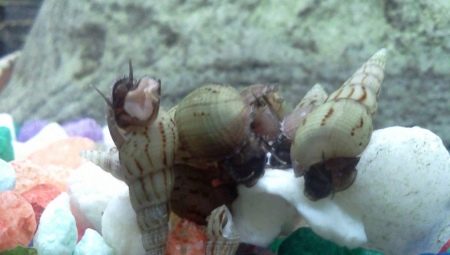
The Melania snail causes conflicting feelings among hobbyists. On the one hand, this species performs a rather important mission in the reservoir to loosen the bottom soil, destroy waste and algae. But they quite often appear in the container uncontrollably - with a substrate or transfer from another aquarium, and uncontrolled reproduction and incredible fertility of the species can even lead to a real invasion of snails. And yet, many give birth to this pet on purpose and remain quite happy with it.
How to make the living of the melania snail safe for the environment in which it is populated? What will be useful for a novice aquarist to describe the granifera and other species of this inhabitant of the underwater world? Before you start a pet with a controversial reputation, you should study in detail all the information about it.


Peculiarities
The melania snail belongs to gastropods and lives in its natural environment in South Africa, but today it can be found in warm water bodies on almost all continents - from Asia to Australia. This genus belongs to the Thiardale family, and was previously known as the tiara among aquarists and in professional literature. Melania is also sometimes called ground snails.
The description of representatives of this genus testifies in some detail to its features. Adults have a body length of up to 3 cm, newborns are difficult to see - they are no more than a grain of sand in the ground. As a matter of fact, small sizes are the culprit for the fact that melania is brought into an aquarium with soil or when buying new fish.
Molluscs have a hard shell, narrow or conical in shape.The colors are as discreet as possible, neutral - dark gray, yellow-green, with pronounced dark stripes.
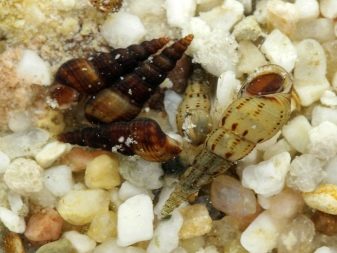

The features of the Melania genus snails include the following.
- The preferred habitat is fine river sand with a fraction diameter of up to 4 mm. Such snails do not live in coarse soil.
- Mostly nocturnal. During daylight hours, molluscs prefer to be in the sand at the bottom of the aquarium.
- Thermophilicity. The optimal living environment should have a temperature above +22 degrees Celsius.
- Fertility. The population grows as quickly as possible and, as it grows, produces many organic compounds in the soil, worsening the living conditions for other inhabitants.
- Gill breathing. Unlike other snails, melania is sensitive to the amount of oxygen in the water. If there is not enough O2, the molluscs are massively taken out of the soil. In fact, their behavior can be used to determine the level of increased water pollution.
- Live birth. Snails carry a pregnancy without laying eggs.
All these factors make Melania quite easily adaptable to various natural conditions. They survive and grow rapidly in any environment.
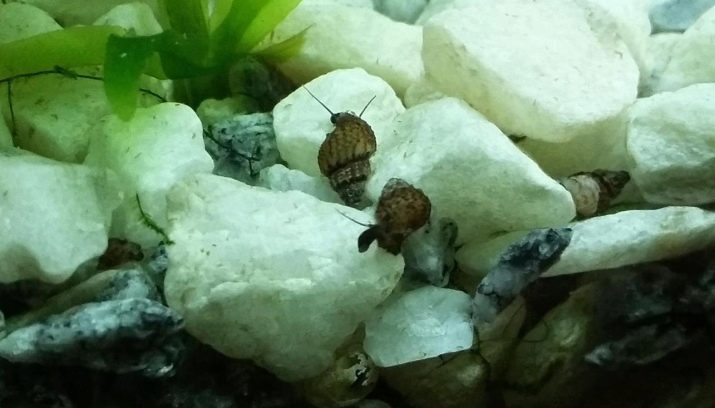
Benefit and harm
The pros and cons of keeping Melania snails are well known to aquarists. Their useful properties include:
- loosening the soil, preventing its acidification, draining the substrate does not allow hydrogen sulfide to contaminate the aquarium;
- removal of organic and food waste from the aquarium, their processing;
- filtration of water with the destruction of green algae and other microorganisms;
- absorption of calcium from water, which makes the environment less harsh;
- indication of water quality - when it deteriorates, snails crawl to the surface.
Not without its drawbacks. In large quantities, multiplied molluscs produce more organic matter than they are processed.
Parasites spread in the water, the general condition of the environment worsens. Having studied the benefits and harms of ground snails, you can evaluate the advisability of keeping them in an aquarium. In this case, the appearance of the mollusk will not come as a surprise.
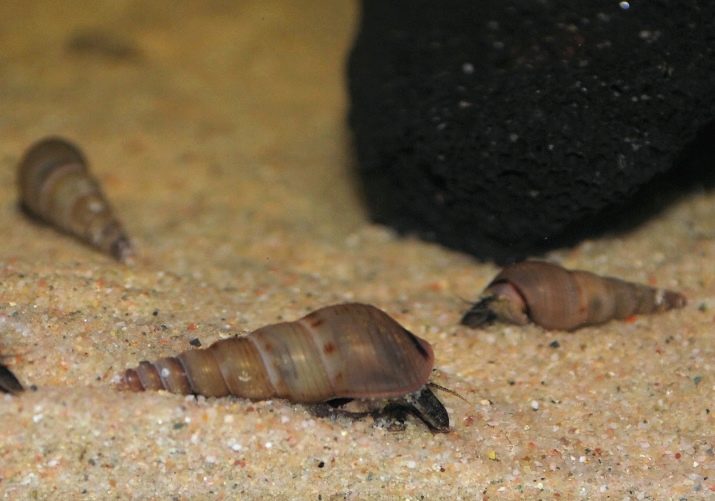
Views
It is known that snails of the genus Melania have two subspecies - Melanoides granifera and Melkanodes tuberculat. Granifera is more decorative, in nature it lives on the territory of Malaysia. Her leg is gray, the shell is decorated in brown and burgundy tones - such a contrast looks decorative and interesting, which is why this subspecies is more popular.
Melania tuberculate snails are larger, from 3.5 cm in length, have a different shell color. Otherwise, the two subspecies are practically the same. Scientists also mention the third variant - Melanoides riqueti, seen in the waters of Singapore. But it bears too much similarity with Melanoides tuberculat and has not yet been identified as a separate species.
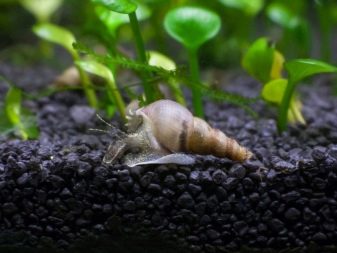

How to choose?
When choosing a melania snail for keeping in an aquarium, you will have to choose between granifera and tuberculate. In fact, we are talking only about the personal preferences of the owner. The tuberculate shell is more pointed, decorated in gray-olive tones. The snail itself can grow up to 7-8 cm, but most often its size does not exceed 3 cm.
The granifera is painted more brightly and, on the whole, looks interesting and decorative. It has a more domed, striped shell. The behavior of snails of this subspecies is also different. They are much slower and spend more time on the surface, exploring the selected territory, actively mastering driftwood and stones.
Granifers have a pronounced territoriality, prefer not to leave occupied habitats.

Content rules
Keeping the melania snail in the aquarium does not require special conditions. This genus is as unpretentious as possible, easily adapts to living in any tank of any size. But the South African origin still makes itself felt - these thermophilic mollusks do not live in too cold an environment.But the melania's endurance reserve is impressive - it is able to coexist even in the same aquarium with fish that feed on snails, thanks to a solid, durable shell.
These inhabitants of the aquatic world spend most of their lives burrowing deep into the ground. So predators like the Tetraodon will have a hard time getting them. By running melanium into the aquarium, you can prevent the substrate from souring. But on the walls of the container, they can be seen only at night. In addition to sand, snails thrive in fine gravel and are not afraid of acidic and hard water. But they need an intense supply of oxygen, the aquarium must be equipped with an aerator.
Melania snails readily attach themselves to the surfaces of decorations. If you place pottery shards, pots, locks, driftwood at the bottom of the aquarium, they will be active exploring these objects. In addition, it will be useful to plant plants with strong roots, tough leaves. They are of no nutritional value to snails.
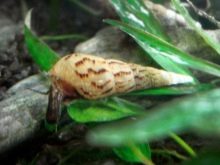
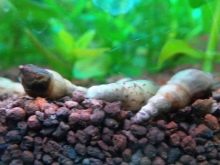
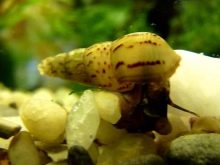
Feeding
Feeding the snails in the aquarium doesn’t require much effort either. They are content with food leftovers, which settle to the bottom, feed on small soft algae, which are a serious biological hazard. If it seems that food is not enough for them, you can treat melania with ready-made dry tablets for catfish, lightly blanched and finely chopped vegetables.
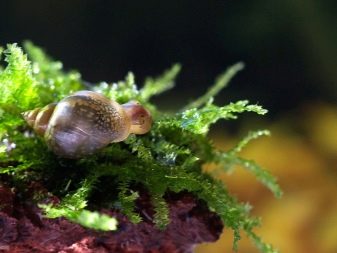
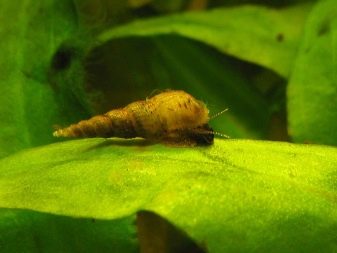
Reproduction and population control
Melania is a species of viviparous snails and bears an egg inside until the offspring are ready to be born. Babies burrow into the ground immediately after birth. The number of newborns is 10-60, depending on the age and size of the mother herself. There is no need to breed melania specially, they can cope with this task on their own.
Melania growth rate is about 5 mm per month. In the event of a power shortage, this process proceeds even more slowly. The size of an adult snail reaches 6 months.
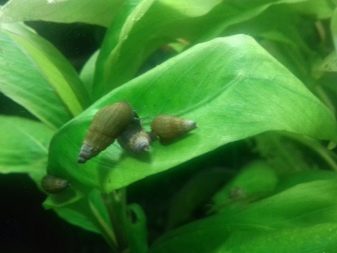
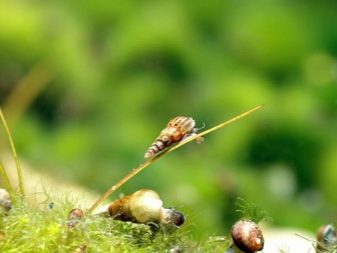
How to get rid of the aquarium?
If melania has multiplied uncontrollably, it is worth taking care that their number is somewhat reduced. Otherwise, the mollusks will obscure the light, filling the glass of the aquariums, and interfere with the filters. The use of special chemicals will help prevent them from accidentally entering the container. But if you do not plan to completely get rid of snails, you will have to control the size of the population differently.
The first reason for the intensive reproduction of melania in the aquarium is too abundant nutrition. If waste has accumulated in the ground, it is worth siphoning it out, removing the excess. Catching and freezing excess individuals will also help. This can be done by simply dropping a blanched cabbage leaf on a plate at the bottom of the aquarium overnight. In the morning it will be possible to collect the "harvest" and destroy it. You should not let the caught melania go down the toilet - they are quite capable of crawling out of the sewer to the surface.
The natural enemy of ground snails is another mollusk - helena. It is a predator with a striped yellow-black shell. It eats smaller brethren, looks very attractive, and helps control the number of potentially dangerous inhabitants of the aquarium.

See the next video about the milania snail.








